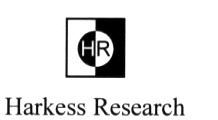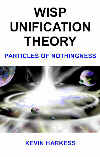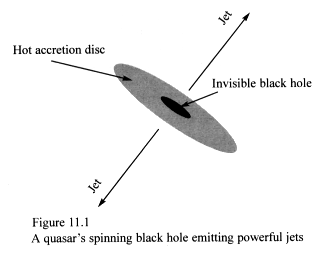
 Wisp
Unification Theory - 11 Big Bang
Wisp
Unification Theory - 11 Big Bang
- Home
- About Me
- Reasons why Einstein was wrong
- One-way speed of light experiments
- Hot topic
- Q&A
- ACES - The end of Relativity

- Book Contents
- Introduction
- 1 Matter,Space and Time
- 2 Symmetry
- 3 Fractals
- 4 Wisp Space
- 5 Gravity
- 6 Electromagnetic Force
- 7 Wisp & S.R: Fundamentals
- 8 Wisp & S.R: Electrodynamics
- 9 Wisp & S.R: Doppler effect
- 10 Wisp & S.R: Relativistic Mechanics
- 11 Big bang
- Appendix A
- Appendix B
- Index A-Z
- Copyright
- Feedback
This page contains the complete chapter. To download the new 2011 2nd edition of wisp unification theory go to the homepage.
11
Big Bang
Cosmologists have collected evidence that clearly shows the universe came
into existence in a big bang event, about 14 billion years ago.
It originated from an infinitely dense point – singularity –
and prior to that explosive event space–time did not exist.
This model supports the cosmological principle, which asserts that on
a large scale the distribution of matter and radiation in the universe
is uniform. The reasoning follows on from the argument that the universe
expanded from a small point. So how galaxies formed in this smoothly expanding
universe remains a mystery.
Wisp theory proposes that the collapse of a spinning ultra-supermassive
black hole created a big bang event that formed the current universe.
And prior to that, the black hole had been steadily growing, feeding on
an expired universe.
11.1 Black holes
11.1.1 General relativity
Einstein’s general theory of relativity predicts the existence of
black holes whose masses are concentrated into infinitely dense points
– singularities.
Wisp theory suggests that at the centre of a black hole is zero-state
space – ‘nothingness’. The mass that makes the black hole
so formidable lies outside its zero-state sphere’s surface, basically
a black hole is an enormous matter-fractal.
Both theories support the notion that curved space causes gravitation.
However, whereas general relativity describes this as a distortion in
the four dimensions of space and time, wisp theory attributes it to three
dimensions of space only.
Figure 11.1 shows a quasar – quasi-stellar source, which is powered
by a spinning supermassive black hole. (Quasars are tiny, but they are
the most luminous objects in the universe – giving off as much energy
as a thousand billion suns.)
The black hole is completely invisible, a tiny speck located at the centre
of the glowing accretion disc, and it emits powerful gamma ray bursts
– jets that travel at near light speed – from its poles.
In its dormant state (non-feeding) the black hole is practically undetectable.
Whereas large black holes grow in size, smaller ones do not, they slowly
expire through emission of ‘Hawking radiation’ (after Stephen
Hawking who first suggested this).

11.1.2 Points of singularity
In wisp theory the smallest point is that of the wisp, and so no points
of singularity exist.
At the centre of a black hole lies zero-state space – ‘emptiness’
– and its mass lies in the wisp space surrounding its zero-state
sphere’s surface, not at its centre.
11.1.3 Supermassive black holes
Astronomers have collected evidence that suggest all galaxies have supermassive
black holes at their centres. Their masses are about 0.5 per cent (typically
several million to a billion solar masses) of that of their host galaxies.
How they came to exist is a mystery, but wisp theory suggests that they
are fragments of zero-state space blasted out during the big bang.
11.1.4 Ultra-supermassive black hole
An ultra-supermassive black hole contains all the energy and zero-state
space needed to create a new universe. Its central zero-state sphere possibly
spans several light years across.
Once its size reaches criticality its structure rapidly collapses, tearing
its central zero-state space apart and blasting fragments out into wisp
space.
A spinning ultra-supermassive black hole produces asymmetry in wisp space
when it collapses, which is responsible for the creation of more matter
than antimatter.
11.2 COBE (launched 1989)
In 1992 NASA’s Cosmic Background Explorer Satellite (COBE) discovered
small variations of 1 part in 100,000 in the temperature of the cosmic
microwave background radiation.
These tiny variations are believed to be the cause of galaxy formation,
although the process by which this happens is not known.
Wisp theory suggests that at the very beginning of the big bang, the explosion
threw out spinning fragments of the ultra-supermassive black hole. So
disturbances in wisp space were already present before the background
radiation formed.
The radiation came from the universe when it was 300,000 years old and
its temperature is estimated to have been around 30,00 K. Now, 14 billion
years later, it has cooled down to just 3 K above absolute zero, barely
detectable but nevertheless clear evidence of an explosive start to the
universe.
11.3 Wisp big bang theory
The big bang event started from the collapse of a spinning ultra-supermassive
black hole. Once it had reached the point of criticality, its structure
collapsed, unleashing enormous gravitational potential energy stored in
wisp space.
Matter-fractals formed immediately around its collapsing zero-state sphere,
causing wisp space to expand, which in turn pushed the broken surface
of the sphere inwards at a speed thousands of times that of light. Opposite
surfaces of the sphere would have smashed together, creating powerful
longitudinal shock waves that travelled at faster than light speed through
wisp space, triggering the formation of matter-fractals along the way.
The continued creation of large numbers of matter-fractals would cause
wisp space to expand rapidly.
The collapsed massive zero-state sphere would have blasted spinning fragments
of zero-state space out into wisp space.
11.3.1 Inflation
In 1979 Alan Guth proposed the idea of inflation to explain unsolved riddles
in the big bang theory.
Immediately following the big bang, the universe underwent a short period
of extremely rapid expansion at a speed thousands of times that of light.
Wisp theory suggests that this resulted from the rapid formation of matter-fractals
– their shapes expand the surrounding wisp space and generate positive
pressure. The huge number of matter-fractals created during the big bang
event would have created enormous positive pressure, causing inflation.
Billions of years on, the positive pressure has weakened to almost zero,
as wisp space continues expanding.
11.3.2 Redshift
In the 1920s Edwin Hubble detected redshifts (shift towards longer wavelengths)
in the spectral lines originating in distant galaxies. He concluded that
they were the Doppler shifts due to the distant galaxies receding at great
speed.
Hubble found a relationship between the speed of recession of galaxies
and their distance from us (Hubble constant), and this provided the first
proof that the universe was expanding.
Wisp theory supports the view that the expansion of wisp space causes
matter-fractals (including supermassive black holes) to move with it.
11.3.3 Galaxy formation
The collapse of the ultra-supermassive black hole caused its central zero-state
sphere to disintegrate rapidly, blasting spinning fragments out into wisp
space. These fragments are the supermassive black holes that formed the
seeds of the galaxies.
Larger fragments would form large galaxies, which in turn would have attracted
smaller fragments, forming the globular clusters that exist in their halos.
Large spinning fragments would form large spiral galaxies; non-spinning
fragments would form elliptical or irregular galaxies; and smaller isolated
fragments would form dwarf galaxies.
11.3.4 Star speeds in rotating galaxies
Supermassive black holes with masses typically several million solar masses
lie at the centres of galaxies.
In theory there should not be a link between the speeds at which outer
stars move in a galaxy and the mass of its black hole, but astronomers
have found that the two are linked. There is a strong possibility that
the presence of the black hole affects the surrounding wisp space, which
has the effect of increasing the gravitational pull on stars in the galaxy.
It is likely that the spin of the black hole causes the surrounding wisp
space to rotate, which in turn causes it to stretch and reduce its density.
In this rotating wisp space matter-fractals’ shapes would distort,
becoming pear-shaped instead of spherical. Their shapes would attempt
to restore to circular symmetry, and in doing so would produce a net additional
force directed towards the black hole. The effect is similar to that which
causes the Pioneer spacecraft to experience an additional retarding force
– see chapter 5, section 5.6 (Pioneers’orbital
discrepancies).
The expansion of wisp space in a rotating galaxy causes an effect that
is similar to a galactic mass increase. This explains the mystery of the
illusive ‘dark matter’, which is believed to cause the stars
to orbit faster.
11.3.5 The big crunch
It is highly probable that the universe will eventually collapse in on
itself in a big crunch event.
Even though there is evidence that the universe is still expanding, due
to positive pressure in wisp space, it is most likely that remnants of
the ultra-supermassive black hole still remain and these will in time
grow sufficiently powerful to begin to exert a rotational influence on
the universe. This will cause an increase in the gravitational pull on
matter that has travelled to the extremities of the universe.
This cycle could possibly take 1000 billion years or more! But may be
shortened if the universe captures material from other universes.
Home --
About Me -- Reasons
why Einstein was wrong -- One-way
speed of light experiments -- Hot
topic -- Q&A
-- ACES
- The end of Relativity --
Book Contents -- Introduction
-- 1 Matter,
Space and Time -- 2
Symmetry -- 3
Fractals -- 4 Wisp Space
-- 5 Gravity -- 6
Electromagnetic Force --
7 Wisp & S.R: Fundamentals
-- 8 Wisp & S.R: Electrodynamics
-- 9 Wisp
& S.R: Doppler effect -- 10
Wisp & S.R: Relativistic Mechanics --
11 Big bang -- Appendix
A -- Appendix B -- Index
A-Z -- Copyright -- Feedback